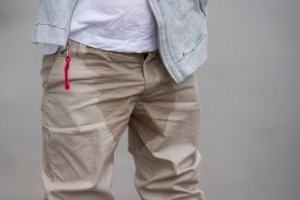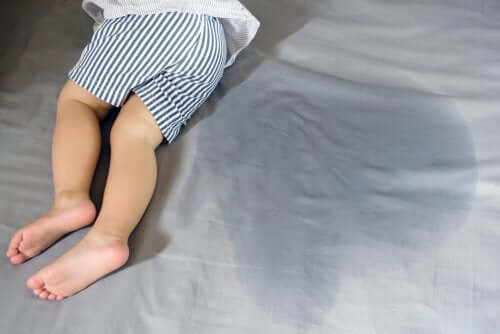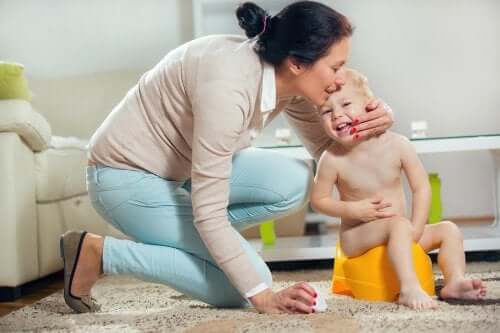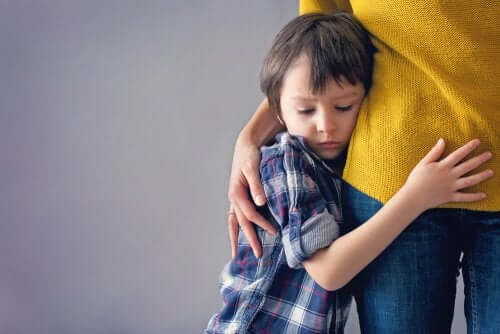Hyperactive Bladder in Children: Causes and Treatments

A hyperactive bladder in children is a syndrome that causes an urgent need to urinate. In some cases, the need is so urgent that it can be difficult to control and may even cause involuntary urination.
Although this condition can occur in both adults and children, this article focuses on hyperactive bladder syndrome in children, its causes, diagnosis, and treatment.
A hyperactive bladder in children
A hyperactive bladder is a syndrome that causes an urgent need to urinate frequently. Normally, it is accompanied by an increase in the frequency of urinating. It’s also the second most common cause of bladder dysfunction in children after bedwetting.
In many cases, the intensity of the urgency makes controlling urination impossible. Therefore, the child may accidentally urinate or have urine leakage. This can also cause serious problems in the child’s life, negatively impacting their social or emotional life.
In fact, if the child accidentally urinates with some frequency, he or she may begin to avoid or refuse to participate in various activities or events for fear of accidentally urinating in front of others. For this reason, it’s important to be aware of the symptoms and consult a specialist as soon as possible.
Symptoms

First, it’s important not to confuse a hyperactive bladder with other conditions, such as bedwetting. The biggest difference between the two is that a hyperactive bladder can present itself at any time of the day.
In general, the following symptoms tend to present themselves:
- Urinating more than 8 times a day.
- Difficulty controlling the need to urinate.
- Urine leakage or loss.
- Sitting cross-legged or in other positions to try to prevent loss of urine.
- In extreme cases, urine incontinence, or the inability to control urination.
- Symptoms can cause distress or affect the normal life of the child.
The causes of hyperactive bladder syndrome
Current theory indicates that an overactive bladder could be related to the late maturation of the central nervous system. Once the bladder is filled, the inhibition reflex of the bladder is not properly activated.
This problem could be related to the child’s physical conditions, such as urinary tract abnormalities, bladder, or kidney infections and a lack of maturation of the central nervous system. However, it could also be related to other conditions, such as constipation.
In some cases, it is because the child has not learned how to correctly control urination (a process that usually begins at 3-5 years). Without learning how to control the sphincter, the child will not be able to properly control urination.
Likewise, conditions such as mental, behavioral, learning, or anxiety disorders, among others, may include hyperactive bladder syndrome as one of its symptoms.
Discover more: Childhood Incontinence and Bedwetting
Diagnosis

To diagnosis a hyperactive bladder, the doctor should perform the following tests and exams:
- Full medical history of both the parents and the child (if applicable). When explaining the medical history, make sure to go into detail about urination habits. In fact, you may be asked to keep a “urination diary” for a few days that records the frequency and intensity of urination of the child. Also, the doctor will consult about any possible triggers.
- Physical examination. This examination will entail a check of the urinary tract area as well through some tests that will check the functioning of the nervous system.
- Urine analysis. This will check for any infections.
- According to the results of the above tests, the doctor may also perform an ultrasound or other urodynamic studies to rule out any other major problems.
Treatment
The treatment of a hyperactive bladder in children will always depend on its causes. For example, if it is caused by constipation, the treatment will be aimed at solving constipation.
In any case, the most common forms of treatment include:
- Bladder training. It can include programming urination (times per hour), urinating twice when going to the bathroom, or relaxing the pelvic muscles, among others.
- In some cases, the doctor may recommend a medical treatment (usually oxybutynin). This will help relieve the symptoms until the child learns to effectively control the sphincter. Once the child has proper control of the sphincter, this will help prevent future urinary tract infections.
- Parental support. Parents should not scold the child under any circumstances. After all, an overactive bladder is not voluntary. On the contrary, you must maintain patient, understanding, and supportive. For instance, even motivational tactics could be established, like rewarding the child when he or she follows the program successfully.
Conclusion

It’s important to be attentive to the symptoms of an overactive bladder. As we explained, it can negatively impact the child socially and emotionally, and ultimately lead to self-esteem problems.
For this reason, it’s important to see a doctor if symptoms or signs related to this syndrome present themselves. This will allow physical problems leading to this syndrome to be quickly treated or ruled out, and the symptoms can be treated and solved.
In any case, parental support is key. For that reason, constant visits to the bathroom or accidental peeing should never be met with criticism, eye-rolling, or scolding. On the contrary, continual support, patience, and understanding are needed.
All cited sources were thoroughly reviewed by our team to ensure their quality, reliability, currency, and validity. The bibliography of this article was considered reliable and of academic or scientific accuracy.
- Alcántara Montero, A. (2016). Novedades en el tratamiento médico de la vejiga hiperactiva. SEMERGEN – Medicina de Familia, 42 (8), 557–565. https://doi.org/10.1016/j.semerg.2015.10.006
- San José González MÁ, Méndez Fernández P. “Incontinencia y trastornos miccionales: ¿qué podemos hacer?” Rev Pediatr Aten Primaria. 2009;11:e1-e29.
- Herndon CD, Joseph DB. “Urinary incontinence”, Pediatr Clin North Am. 2006;53(3):363-77.
- Fernández Fernández M, Cabrera Sevilla JE. “Trastornos miccionales y enuresis en la infancia”,
Protoc diagn ter pediatr. 2014;1:119-34 - Asociación Española de Urología (AEU). Vejiga hiperactiva en pediatría. Consultado en línea en: https://aeuexp.aeu.es/areas-de-experiencia/urologia-infantil/vejiga-hiperactiva-en-pediatria/
- Asociación de Pediatría. “Enuresis. Mojar la cama”. Consultado en línea en: https://enfamilia.aeped.es/temas-salud/enuresis
This text is provided for informational purposes only and does not replace consultation with a professional. If in doubt, consult your specialist.








